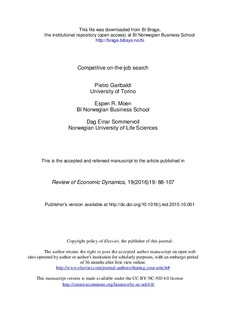Competitive on-the-job search
Journal article, Peer reviewed
Permanent lenke
http://hdl.handle.net/11250/2389061Utgivelsesdato
2016Metadata
Vis full innførselSamlinger
- Scientific articles [2181]
Originalversjon
Review of Economic Dynamics, 19(2016)19: 88-107 http://dx.doi.org/10.1016/j.red.2015.10.001Sammendrag
The paper proposes a model of on-the-job search and industry dynamics in which search
is directed. Firms permanently di er in productivity levels, their production function features
constant returns to scale, and search costs are convex in search intensity. Wages are determined
in a competitive manner, as rms advertise wage contracts (expected discounted incomes) so
as to balance wage costs and search costs (queue length). Firms are assumed to sort out their
coordination problems with their employees in such a way that the on-the-job search behavior of
workers maximizes the match surplus. Our model has several novel features. First, it is close in
spirit to the competitive model, with a tractable and unique equilibrium, and is therefore useful
for empirical testing. Second, on-the-job search is an e cient response to rm heterogeneities
and convex search costs. Third, the equilibrium leans towards a job ladder, where unemployed
workers apply to low-productivity rms o ering low wages, and then gradually move on to more
productive, higher-paying rms. With a continuum of rm types, the job ladder i strict, in the
sense that there is a one-to-one correspondence between the productivity of the current employer
and that of the rms she searches for. The paper also contributes methodologically, as the
existence proof requires a version of Schauder's xed point theorem that is not commonly used
by economists. Finally, our model o ers di erent implications for the dynamics of job-to-job
transitions than existing models of random search.
Beskrivelse
This is the accepted and refereed manuscript to the article
